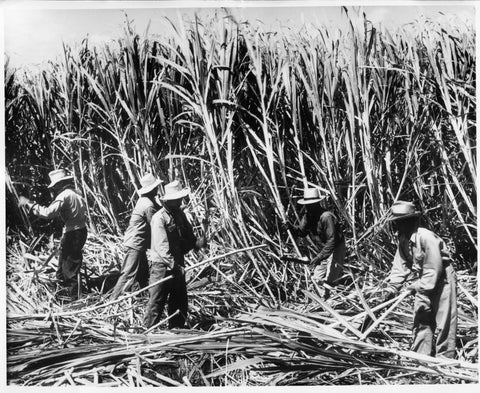Guns, Germs, and Sugar | Hawai`i's Roots - Episode 2
Aloha,
Welcome back to Hawai`i's Roots. Last episode we covered the origins of the Native Hawaiian people and the ingenious ahupua`a system that sustained them for over one thousand years. In this next edition of the history of Hawai`i and its agriculture, we take a look at the period between 1778 and the present day. The introduction of guns, germs and sugar, in addition to increasing political complications arising from a growing global presence, marked the beginning of a new phase of Hawaiian history, accompanied by the deterioration of the effective and optimized ahupua`a system.
The Mark of a New Era
Shortly after Captain James Cook’s arrival in 1778, Hawai`i was placed on the world map, and began conducting business and dealing with issues the islands had never faced before. Trade with other nations began in 1805 with the historic sandalwood industry. While economically prosperous, the Hawaiian population experienced periods of famine throughout the newly-formed industry’s dominance due to the reassignment of resources from agriculture to trade. The over-harvesting of trees quickly led to the exhaustion of sandalwood resources, and this new industry faded away completely by the 1840s.
In addition to the sandalwood industry, the discovery of whaling grounds off the coasts of Japan and Peru led Hawai`i to become a crucial port for whaling ships, with the first ship arriving in 1820. By the late 1820s, over 150 were stopping annually at the Islands. However, this too faded away with the rise of oil in the mid-1800s, and mostly disappeared by the 1870s.

Hawai`i Sugar Cane Plantation
The Industrial Magnet and Population Problems
While other industries failed, one managed to stay around for much longer: sugar. Ladd and Co. started the first sugar plantation on Kaua`i in 1835 and experienced moderate growth through to the 1850s. Up until 1876, high tariffs limited the industry’s expansion. But with the introduction of the 1876 reciprocity treaty, which allowed duty-free sales of Hawai`i goods into the U.S., exports suddenly became more affordable.
Sugar exports grew from 21 million pounds in 1876 to 225 million pounds in 1890, and this growth increased demand for overseas contract laborers, with plantation employment rising from 3,921 in 1872 to 20,536 in 1892. This number only rose as the United States annexed Hawai`i in 1900, marking the beginning of a flood of immigrants from all over the world. Sugar production continued to skyrocket, from 289,500 tons in 1900 to 939,300 tons in 1930. Pineapple production grew also, from 2,000 cases in 1903 to 12,808,000 in 1931.
While population growth was high in terms of total population, Native Hawaiian population saw massive decline. Native Hawaiian population estimates in 1778 range from 110,000 to 1,000,000, but by 1900, hit the lowest level on record of 39,656.
Hawai`i certainly did not escape the effects of the Great Depression and following World War II, either. The depression crushed industrial output as global demand lowered, raising the unemployment rate on the islands to around 25%. While increased personnel levels at Pearl Harbor increased demand for retail, restaurant, and other consumer services, this demand left shortly after the War’s end as soldiers returned to the U.S. mainland. Newly-formed labor unions and the following strikes disrupted the production of sugar and pineapple in 1950, and Hawai`i’s economy began the final phase of its transition from agriculture to its current economy: tourism.

Hawai`i Tourism Explodes
The New Economy
The introduction of propeller-driven commercial service in 1946 and then commercial jet service in 1959 put Hawai`i on the map for many individuals, building the newly-made state’s tourism economy for many decades, landing us where we are today. While Hawai`i has certainly benefited from becoming a much-loved travel destination, this economic growth has not come without a price for both the island and its residents.
In the next and final episode of Hawai`i's Roots, we will take a look at the current state of Hawaiian agricultural and learn how we can each do our part to support the foundation of these Islands’ existence: Food and people. You can find this episode here.
Mahalo Nui Loa,
- Kaunamano Farm